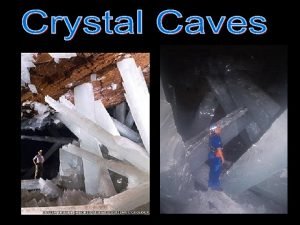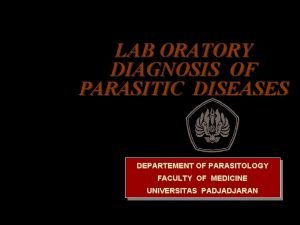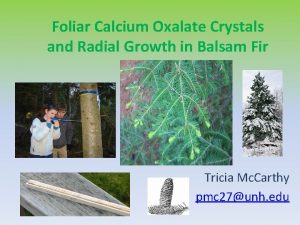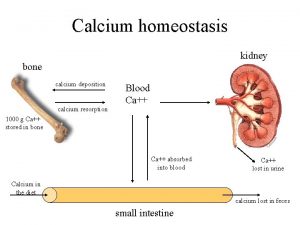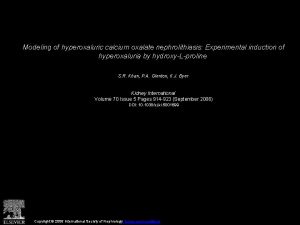Foliar Calcium Oxalate Crystals and Radial Growth in



















- Slides: 19

Foliar Calcium Oxalate Crystals and Radial Growth in Balsam Fir Tricia Mc. Carthy pmc 27@unh. edu

5 th Year 4 Y 4 th Year 3 Y 3 Y 3 rd Year 2 Y 2 Y CY CY 2 nd Year CY Current Year

Study Site: USFS Hubbard Brook Experimental Forest, Thornton, NH

Site Description • 3160 hectares (137, 649, 600 acres) reserved by the USFS in the White Mountain National Forest, established in 1955 • northern hardwood forests on lower slopes and spruce-fir on upper reaches • coarse, acidic, glacially-derived soils • study plots are on south-facing slopes with an elevation of approximately 2600 feet.

The Hubbard Brook Experimental Forest

Hubbard Brook Watersheds 1 -6

In October 1999 the Ca content of the soil in Watershed 1 was increased through the application of Wollastonite (Ca. Si. O 3).

Why is calcium important? Prevailing weather conditions bring acidic clouds and air masses from the west. NH’s bedrock and soils provide poor buffering for acidic deposition. Soil calcium depletion is a problem in the northeast. Calcium is an important nutrient for plant growth. Ø Membrane calcium is needed for nutrient absorption and transport in foliar and root tissue. Ø Calcium pectate in the middle lamella acts as a glue to bind cells together.

Hypothesis: Watershed 1, the calcium-amended watershed, will have more Calcium. Oxalate crystals and enhanced tree growth than Watershed 6, the reference watershed.

Research Methods: • Bough and core samples were collected from 15 trees in Watershed 1 and 18 trees in Watershed 6. • A sub-sample of needles were cross-sectioned analyzed using a Scanning Electron Microscope (SEM) and Energy Dispersive X-Ray (EDX) analysis, to look for trends in the concentration of Ca. Ox crystals. • Cores were examined using a dissecting microscope and a mm ruler to measure annual growth. • A radial growth index was established for each tree in order to reduce the natural variance in growth rates of individual trees.

Collecting cores at Hubbard Brook

Procedure used to establish a radial growth index: • The mean annual increment width was calculated for the entire core. • This value was then subtracted from each increment measurement. • An index value greater than 0 indicates above average growth. Negative numbers represent below average growth.


Calcium Oxalate Crystals (SEM)

Why do plants form calcium oxalate crystals? Some hypotheses include: v Calcium regulation in environments where soluble Ca is abundant v Protection as a defense against herbivores v Detoxification (e. g. oxalic acid) o Calcium Sequestration for future fertilization? o Ion balance? o Tissue support/plant rigidity? o Light gathering and reflection?

SEM EDX Spectrum Comparing Tree #461 CY needles (green) to 5 Y needles (red). In general, we see increased Ca concentrations in older needles, regardless of the watershed. The inverse relationship between potassium and calcium is an interesting phenomenon that has also been seen in spruce needles using a different analysis.

20, 0 18, 0 Watershed 1 (Ca amended) 16, 0 20, 0 18, 0 Watershed 6 (reference) 16, 0 14, 0 12, 0 % Calcium 14, 0 12, 0 10, 0 Growth Index 10, 0 8, 0 6, 0 4, 0 2, 0 0, 0 % Calcium Growth Index 0, 0 2007 2003 2007 Comparisons between the two study plots: 2003 Growth Index: more radial growth is shown in the Ca amended watershed in 2007 (CY) than in the reference watershed; however, the reference watershed shows more growth in 2003 (5 Y) than the Ca amended watershed. Percent Calcium: a higher percentage of calcium oxalate crystals were measured in needles from the Ca amended watershed in both CY and 5 Y needles. There doesn’t appear to be a correlation between % Ca and growth in these samples. Other factors may have affected the growth of the reference watershed trees in 2003 (less competition due to ice storm damage in 1998? ).

Conclusions: Current year and 5 year needles from the calciumamended watershed have a higher concentration of Ca. Ox crystals than needles from the reference watershed. More radial (wood) growth was seen in the calciumamended watershed in 2007. The reference watershed shows more radial growth in 2003. Radial growth in watershed 1 increased consistently after the Ca amendment; growth in Watershed 6 was variable, peaking in 2004 and declining over the past three years. More research is needed to determine if increased concentrations of Ca. Ox crystals are associated with increased radial growth.

References: Hawley, G. J. , Schaberg, P. G. , Eager, C. , Borer, C. H. , 2006. Calcium addition at the Hubbard Brook Experimental Forest reduced winter injury to red spruce in a high-injury year. Can. J. For. Res. 36: 1 -6. Hudgins, J. W. , Krekling, T. , Franceschi, V. R. (2003). Distribution of calcium oxalate crystals in the secondary phloem of conifers: a constitutive defense mechanism? New Phytologist 159: 677 -690. Schaberg, P. G. , De. Hayes D. H. , Hawley G. J. , 2001. Anthropogenic Calcium Depletion: A Unique Threat to Forest Ecosystem Health? Ecosystem Health 7: 214– 228. Smith, K. T. and Shortle, W. C. (2003) Radial Growth of hardwood following the 1998 ice storm in New Hampshire and Maine. Can. J. For. Res. 33: 3325 -329. http: //www. hubbardbrook. org
 Urine crystals calcium oxalate
Urine crystals calcium oxalate Urolithiasis
Urolithiasis What is this ?
What is this ? Foliar nematodes treatment
Foliar nematodes treatment The functional unit of the kidney is the .
The functional unit of the kidney is the . Anti radial vs radial ultrasound
Anti radial vs radial ultrasound Growth analysis
Growth analysis Pith
Pith Primary growth and secondary growth in plants
Primary growth and secondary growth in plants Primary growth and secondary growth in plants
Primary growth and secondary growth in plants Step growth polymerization vs chain growth
Step growth polymerization vs chain growth Geometric growth graph
Geometric growth graph Neoclassical growth theory vs. endogenous growth theory
Neoclassical growth theory vs. endogenous growth theory Organic vs inorganic growth
Organic vs inorganic growth Largest crystals
Largest crystals String test synovial fluid
String test synovial fluid Rock candy experiment lab report
Rock candy experiment lab report Are crystals pure substances
Are crystals pure substances Charcot leyden crystals parasites
Charcot leyden crystals parasites Why do ionic bonds form crystals
Why do ionic bonds form crystals














